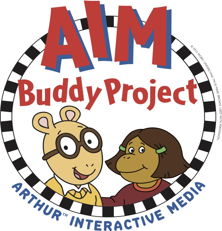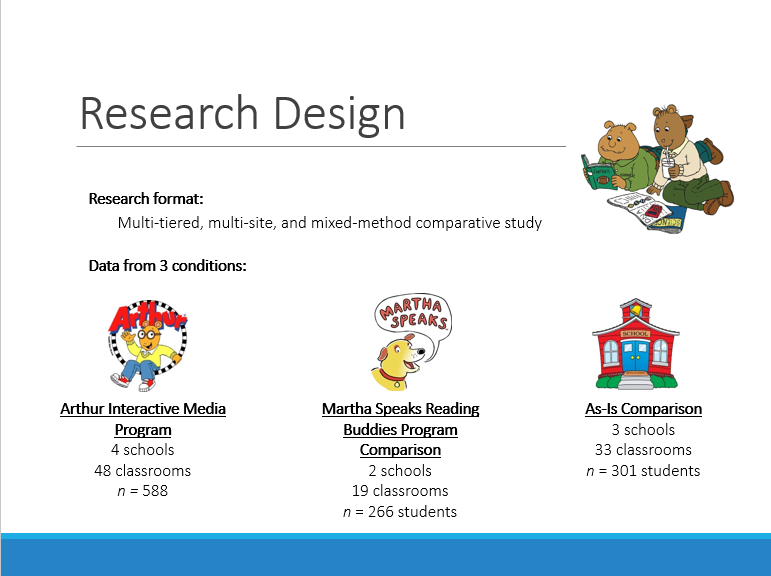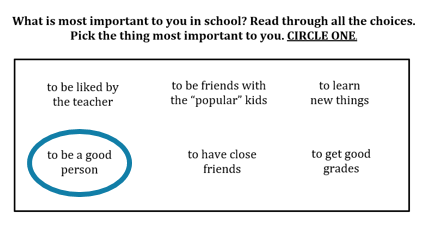Last month, researchers AnneMarie McClain and Lacey Hilliard presented some exciting findings from a a study they conducted around classroom media and socio-emotional learning among elementary school students at the International Communication Association Conference in Prague. We invited them to share details of the project as well as the findings that emerged from their investigation.
 At the May 2018 International Communication Association Conference in Prague, Czech Republic, we presented some findings from our longitudinal study, the Arthur Interactive Media (AIM) Buddy Project. Together with WGBH-Boston, we developed interactive media and related curriculum designed to foster socio-emotional and character development and to help promote elementary school students’ empathy, tolerance, and prosocial values in school.
The project included a suite of five digital comics and games based on content from the Arthur© television program, embedded in a curriculum with classroom lessons. The comics, games, and classroom components focus on five main topics: empathy, learning from others, generosity, honesty, and forgiveness. The program was implemented during the 2015-2016 school year in 48 classrooms of racially, ethnically, and socioeconomically diverse students in the Northeastern United States. First graders were paired with fourth graders and second graders were paired with fifth graders to engage in the comics and games, and teachers led classroom sessions during the regular school day. Each comic and game included interactive features, such as built-in reflection questions to prompt discussion about characters’ unspoken mental states and choose-your-own endings that allow children to explore the consequences of characters’ various prosocial and less prosocial actions.
At the May 2018 International Communication Association Conference in Prague, Czech Republic, we presented some findings from our longitudinal study, the Arthur Interactive Media (AIM) Buddy Project. Together with WGBH-Boston, we developed interactive media and related curriculum designed to foster socio-emotional and character development and to help promote elementary school students’ empathy, tolerance, and prosocial values in school.
The project included a suite of five digital comics and games based on content from the Arthur© television program, embedded in a curriculum with classroom lessons. The comics, games, and classroom components focus on five main topics: empathy, learning from others, generosity, honesty, and forgiveness. The program was implemented during the 2015-2016 school year in 48 classrooms of racially, ethnically, and socioeconomically diverse students in the Northeastern United States. First graders were paired with fourth graders and second graders were paired with fifth graders to engage in the comics and games, and teachers led classroom sessions during the regular school day. Each comic and game included interactive features, such as built-in reflection questions to prompt discussion about characters’ unspoken mental states and choose-your-own endings that allow children to explore the consequences of characters’ various prosocial and less prosocial actions.

Screenshots showing an example of interactive features of So Funny I Forgot to Laugh, a comic focused on promoting empathy and humility and reducing instances of bullying in school. Click to enlarge. 
An overview of the types of data collected throughout the AIM study. Click to enlarge. 
An overview of the AIM research design 
A snapshot of the student survey question prompting children to select their most important value in school  AnneMarie McClain is a doctoral student under the mentorship of Professor Marie-Louise Mares in the Department of Communication Arts at the University of Wisconsin-Madison. Her research interests center around understanding how media – and interactions around media – can be designed to better promote positive outcomes for children and families, especially children of color and those from lower-income backgrounds. She is a former elementary school teacher who has taught in Brooklyn, New York and rural Costa Rica and who has developed curricula for preschool and elementary school children in the United States, Costa Rica, and Kenya. She holds a master’s degree in human development and psychology from the Harvard Graduate School of Education, a master’s degree in childhood education from CUNY Hunter, and a bachelor’s degree in anthropology from Williams College.
AnneMarie McClain is a doctoral student under the mentorship of Professor Marie-Louise Mares in the Department of Communication Arts at the University of Wisconsin-Madison. Her research interests center around understanding how media – and interactions around media – can be designed to better promote positive outcomes for children and families, especially children of color and those from lower-income backgrounds. She is a former elementary school teacher who has taught in Brooklyn, New York and rural Costa Rica and who has developed curricula for preschool and elementary school children in the United States, Costa Rica, and Kenya. She holds a master’s degree in human development and psychology from the Harvard Graduate School of Education, a master’s degree in childhood education from CUNY Hunter, and a bachelor’s degree in anthropology from Williams College. Lacey J. Hilliard, Ph.D. is a Research Assistant Professor at the Institute for Applied Research in Youth Development in the Eliot-Pearson Department of Child Study and Human Development at Tufts University. She earned her Ph.D. in developmental psychology from the Pennsylvania State University. Dr. Hilliard’s research takes an applied developmental approach to helping children navigate difficult topics. Specifically, she focuses on how children process and respond to information about social groups (e.g., gender and race) as well as the potential for programs aimed at promoting prosocial development via conversations through media and technology. She was a principal investigator on the AIM study described in this blog and is currently leading the Quandary Project, which is designed to help educators facilitate challenging conversations about ethical decisions through digital game play.
Lacey J. Hilliard, Ph.D. is a Research Assistant Professor at the Institute for Applied Research in Youth Development in the Eliot-Pearson Department of Child Study and Human Development at Tufts University. She earned her Ph.D. in developmental psychology from the Pennsylvania State University. Dr. Hilliard’s research takes an applied developmental approach to helping children navigate difficult topics. Specifically, she focuses on how children process and respond to information about social groups (e.g., gender and race) as well as the potential for programs aimed at promoting prosocial development via conversations through media and technology. She was a principal investigator on the AIM study described in this blog and is currently leading the Quandary Project, which is designed to help educators facilitate challenging conversations about ethical decisions through digital game play.
 At the May 2018 International Communication Association Conference in Prague, Czech Republic, we presented some findings from our longitudinal study, the Arthur Interactive Media (AIM) Buddy Project. Together with WGBH-Boston, we developed interactive media and related curriculum designed to foster socio-emotional and character development and to help promote elementary school students’ empathy, tolerance, and prosocial values in school.
The project included a suite of five digital comics and games based on content from the Arthur© television program, embedded in a curriculum with classroom lessons. The comics, games, and classroom components focus on five main topics: empathy, learning from others, generosity, honesty, and forgiveness. The program was implemented during the 2015-2016 school year in 48 classrooms of racially, ethnically, and socioeconomically diverse students in the Northeastern United States. First graders were paired with fourth graders and second graders were paired with fifth graders to engage in the comics and games, and teachers led classroom sessions during the regular school day. Each comic and game included interactive features, such as built-in reflection questions to prompt discussion about characters’ unspoken mental states and choose-your-own endings that allow children to explore the consequences of characters’ various prosocial and less prosocial actions.
At the May 2018 International Communication Association Conference in Prague, Czech Republic, we presented some findings from our longitudinal study, the Arthur Interactive Media (AIM) Buddy Project. Together with WGBH-Boston, we developed interactive media and related curriculum designed to foster socio-emotional and character development and to help promote elementary school students’ empathy, tolerance, and prosocial values in school.
The project included a suite of five digital comics and games based on content from the Arthur© television program, embedded in a curriculum with classroom lessons. The comics, games, and classroom components focus on five main topics: empathy, learning from others, generosity, honesty, and forgiveness. The program was implemented during the 2015-2016 school year in 48 classrooms of racially, ethnically, and socioeconomically diverse students in the Northeastern United States. First graders were paired with fourth graders and second graders were paired with fifth graders to engage in the comics and games, and teachers led classroom sessions during the regular school day. Each comic and game included interactive features, such as built-in reflection questions to prompt discussion about characters’ unspoken mental states and choose-your-own endings that allow children to explore the consequences of characters’ various prosocial and less prosocial actions.




 AnneMarie McClain is a doctoral student under the mentorship of Professor Marie-Louise Mares in the Department of Communication Arts at the University of Wisconsin-Madison. Her research interests center around understanding how media – and interactions around media – can be designed to better promote positive outcomes for children and families, especially children of color and those from lower-income backgrounds. She is a former elementary school teacher who has taught in Brooklyn, New York and rural Costa Rica and who has developed curricula for preschool and elementary school children in the United States, Costa Rica, and Kenya. She holds a master’s degree in human development and psychology from the Harvard Graduate School of Education, a master’s degree in childhood education from CUNY Hunter, and a bachelor’s degree in anthropology from Williams College.
AnneMarie McClain is a doctoral student under the mentorship of Professor Marie-Louise Mares in the Department of Communication Arts at the University of Wisconsin-Madison. Her research interests center around understanding how media – and interactions around media – can be designed to better promote positive outcomes for children and families, especially children of color and those from lower-income backgrounds. She is a former elementary school teacher who has taught in Brooklyn, New York and rural Costa Rica and who has developed curricula for preschool and elementary school children in the United States, Costa Rica, and Kenya. She holds a master’s degree in human development and psychology from the Harvard Graduate School of Education, a master’s degree in childhood education from CUNY Hunter, and a bachelor’s degree in anthropology from Williams College. Lacey J. Hilliard, Ph.D. is a Research Assistant Professor at the Institute for Applied Research in Youth Development in the Eliot-Pearson Department of Child Study and Human Development at Tufts University. She earned her Ph.D. in developmental psychology from the Pennsylvania State University. Dr. Hilliard’s research takes an applied developmental approach to helping children navigate difficult topics. Specifically, she focuses on how children process and respond to information about social groups (e.g., gender and race) as well as the potential for programs aimed at promoting prosocial development via conversations through media and technology. She was a principal investigator on the AIM study described in this blog and is currently leading the Quandary Project, which is designed to help educators facilitate challenging conversations about ethical decisions through digital game play.
Lacey J. Hilliard, Ph.D. is a Research Assistant Professor at the Institute for Applied Research in Youth Development in the Eliot-Pearson Department of Child Study and Human Development at Tufts University. She earned her Ph.D. in developmental psychology from the Pennsylvania State University. Dr. Hilliard’s research takes an applied developmental approach to helping children navigate difficult topics. Specifically, she focuses on how children process and respond to information about social groups (e.g., gender and race) as well as the potential for programs aimed at promoting prosocial development via conversations through media and technology. She was a principal investigator on the AIM study described in this blog and is currently leading the Quandary Project, which is designed to help educators facilitate challenging conversations about ethical decisions through digital game play.